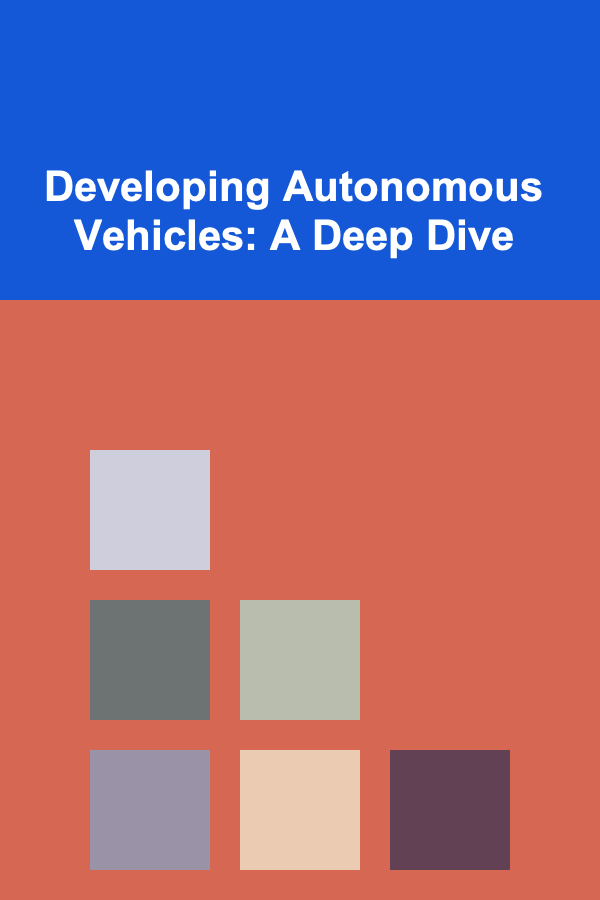
How to Monetize Your Deep Learning Skills as a Freelancer
ebook include PDF & Audio bundle (Micro Guide)
$12.99$5.99
Limited Time Offer! Order within the next:

Deep learning, a powerful subset of machine learning, has transformed many industries, from healthcare and finance to retail and entertainment. With the demand for AI-driven solutions rapidly growing, deep learning expertise has become a valuable skill. As a freelancer, you can capitalize on this demand by monetizing your deep learning skills. Whether you're an experienced AI practitioner or just starting in the field, there are multiple strategies you can employ to build a successful freelance career in deep learning.
In this article, we will explore various ways to monetize your deep learning skills as a freelancer, offer practical advice for success, and outline key steps to establishing a sustainable business model. The goal is to guide you through creating a thriving freelance career leveraging deep learning, ensuring that your skill set is both valued and compensated.
Understanding Deep Learning and Its Applications
Before diving into the monetization strategies, it's essential to understand the core concepts of deep learning and its real-world applications. Deep learning involves training artificial neural networks on large datasets to recognize patterns, make predictions, and automate complex tasks.
Some of the key applications of deep learning include:
- Image and Video Processing: Deep learning models like convolutional neural networks (CNNs) are used for image recognition, object detection, and video analysis. These technologies power applications in autonomous vehicles, surveillance systems, and medical imaging.
- Natural Language Processing (NLP): Deep learning is central to NLP tasks, such as sentiment analysis, machine translation, text summarization, and chatbots. Models like transformers and recurrent neural networks (RNNs) are widely used in these domains.
- Predictive Analytics: Deep learning models are used in finance, healthcare, and marketing to predict trends, detect fraud, and forecast future events based on historical data.
- Speech Recognition: Deep learning has also driven advancements in speech recognition technologies, such as virtual assistants (e.g., Siri, Alexa) and transcription services.
- Reinforcement Learning: In areas like robotics and game development, reinforcement learning is used to create intelligent agents that can learn optimal actions through trial and error.
Understanding these applications allows you to identify which areas align with your expertise and interests, helping you tailor your freelance offerings.
Building a Strong Foundation for Freelance Success
2.1 Strengthening Your Deep Learning Skills
To monetize your deep learning skills effectively, it's essential to build a strong foundation in the field. While deep learning models and algorithms can be complex, you should aim to become proficient in the following areas:
- Mathematics and Statistics: Understanding the underlying mathematical concepts of deep learning, such as linear algebra, calculus, probability, and optimization, is crucial for building and fine-tuning models.
- Programming: Deep learning primarily relies on programming languages like Python, and libraries such as TensorFlow, PyTorch, Keras, and scikit-learn. Being proficient in these tools is fundamental to implementing deep learning solutions.
- Model Development: Understanding how to design, train, evaluate, and deploy deep learning models is essential. Familiarize yourself with model architectures such as CNNs for image tasks, RNNs for sequence-based tasks, and transformers for NLP.
- Data Handling and Preprocessing: Deep learning models require large datasets for training. Knowing how to collect, clean, preprocess, and augment data is crucial for achieving good model performance.
Online courses, tutorials, books, and practical projects can help you solidify these foundational skills. Some platforms where you can learn deep learning include:
- Coursera (Deep Learning Specialization by Andrew Ng)
- Fast.ai (Practical Deep Learning for Coders)
- Udacity (Deep Learning Nanodegree)
Once you've honed your technical skills, the next step is to develop a portfolio of deep learning projects that showcase your abilities to potential clients.
2.2 Building a Portfolio
In the competitive freelance market, having a strong portfolio is essential. A well-curated portfolio demonstrates your expertise and shows prospective clients that you have the practical experience to deliver results. Here's how to build an impressive deep learning portfolio:
- Showcase Real-World Projects: Create and share deep learning projects that solve actual problems. For example, you could build a facial recognition system, a text classification model, or an AI-powered recommendation engine.
- Document Your Work: Use GitHub or personal blogs to document your projects. Include code, explanations of your models, and the results you achieved. Make sure your projects are clearly structured, well-documented, and easy to follow.
- Diverse Project Types: Aim for diversity in your projects. For instance, include projects that cover image processing, NLP, time-series forecasting, and reinforcement learning. This will showcase your versatility and appeal to a broader range of clients.
- Collaborate on Open-Source Projects: Contributing to open-source deep learning projects can help you gain recognition in the community and demonstrate your ability to collaborate with other developers.
A portfolio with a strong variety of projects will help set you apart from other freelancers and show potential clients that you have the skill set they need.
Identifying High-Demand Freelance Opportunities
The next step in monetizing your deep learning skills is identifying high-demand freelance opportunities. As deep learning has applications across numerous industries, there are several areas where businesses are actively seeking freelance talent. Here are some of the top niches for deep learning freelancers:
3.1 Healthcare and Medical AI
AI-driven solutions are transforming healthcare, from diagnostics to drug discovery. Freelancers with expertise in medical imaging, predictive analytics, and healthcare-related NLP can find lucrative opportunities in this space. You might work on projects like:
- Medical Image Analysis: Developing deep learning models to analyze medical images (e.g., MRI scans, X-rays) for detecting diseases like cancer or abnormalities.
- Predictive Healthcare: Building models to predict patient outcomes, optimize hospital resources, or forecast disease outbreaks.
- Clinical Text Analysis: Using NLP techniques to analyze electronic health records (EHRs) for insights into patient care and medical research.
3.2 Autonomous Systems
Autonomous systems, including self-driving cars, drones, and robotics, rely heavily on deep learning for decision-making and environment perception. Freelancers can contribute by:
- Developing computer vision models for object detection and tracking in autonomous vehicles or drones.
- Implementing reinforcement learning algorithms for robotic control and optimization.
- Creating models for real-time decision-making in autonomous systems.
3.3 Finance and Trading
The finance sector is increasingly adopting AI for risk assessment, fraud detection, algorithmic trading, and market prediction. Freelancers with a strong understanding of financial data can find opportunities in areas such as:
- Algorithmic Trading: Designing AI-powered trading bots and strategies that can automatically execute trades based on market data.
- Fraud Detection: Implementing deep learning models to detect fraudulent activity or anomalies in financial transactions.
- Risk Assessment: Building predictive models to assess credit risk, insurance claims, or investment portfolios.
3.4 E-Commerce and Marketing
In the e-commerce space, AI is used for personalized recommendations, customer segmentation, and demand forecasting. Freelancers can find opportunities by developing solutions like:
- Recommendation Systems: Building AI-based recommendation engines for products, content, or services.
- Customer Sentiment Analysis: Using NLP to analyze customer reviews, social media posts, and feedback to gauge sentiment and brand perception.
- Dynamic Pricing: Implementing models that adjust prices based on demand, competition, and other factors in real-time.
3.5 Natural Language Processing and Chatbots
Natural Language Processing (NLP) is an area of deep learning that has a wide range of applications, including chatbots, virtual assistants, and document analysis. Freelancers specializing in NLP can work on projects such as:
- Conversational AI: Developing chatbots or voice assistants for customer service, sales, or support.
- Text Summarization: Creating models that automatically summarize large volumes of text (e.g., articles, research papers, reports).
- Sentiment Analysis: Building models that assess customer sentiment from text data (e.g., reviews, social media posts).
Setting Your Freelance Business Up for Success
4.1 Finding Clients
Finding clients is one of the biggest challenges for freelancers. There are several ways to connect with potential clients:
- Freelance Platforms: Websites like Upwork, Freelancer, and Toptal are great platforms for finding freelance work in deep learning. Create a detailed profile, showcasing your portfolio and expertise.
- Networking: Attend AI conferences, webinars, and meetups (virtually or in person) to connect with potential clients and collaborators.
- Cold Outreach: Identify companies that may benefit from deep learning solutions and send personalized proposals outlining how your services can help solve their problems.
- Social Media and Blogging: Share your projects and insights on platforms like LinkedIn, Twitter, and Medium to increase your visibility in the deep learning community and attract clients.
4.2 Setting Pricing and Negotiating Contracts
Freelancers often struggle with pricing their services. To set competitive and sustainable rates, consider the following:
- Hourly vs. Project-Based: Decide whether to charge by the hour or based on the project. Hourly rates are common for smaller tasks, while project-based pricing is better for larger, well-defined projects.
- Research Market Rates: Investigate the average rates for deep learning freelancers in your region or industry. Websites like Glassdoor and PayScale can provide useful insights.
- Negotiation: When negotiating contracts, be clear about your deliverables, timelines, and terms of payment. Don't be afraid to negotiate for higher rates if you feel your expertise justifies it.
4.3 Managing Your Freelance Business
Running a successful freelance business goes beyond just coding. As a freelancer, you will also need to handle administrative tasks such as invoicing, tax filing, and managing client relationships. Tools like QuickBooks, Trello, and Slack can help you manage your projects and finances efficiently.
Scaling Your Freelance Business
As you gain more experience and grow your client base, you can scale your freelance business by:
- Outsourcing: Hire other freelancers or subcontractors to help with larger projects, allowing you to take on more work.
- Creating Products: Develop and sell your own deep learning products, such as pre-trained models, courses, or AI-driven software.
- Building a Brand: Establish yourself as an expert in the field by publishing research, writing blog posts, or speaking at conferences.
Conclusion
Monetizing your deep learning skills as a freelancer can be both lucrative and fulfilling. By continuously honing your technical expertise, building a strong portfolio, and identifying high-demand freelance opportunities, you can create a thriving freelance career. With the right strategies, dedication, and entrepreneurial mindset, deep learning freelancing offers immense potential for long-term success and growth.

How to Build Trust with Your Customers in the Automotive Niche
Read More
How to Handle Rent Increases and Stay Competitive in the Market
Read More
How to Maximize Home Security in an Urban Setting
Read More
Market Research Analyst's Handbook: Best Practices for Conducting Surveys and Analyzing Trends
Read More
How To Protect Your Brain from Age-Related Decline
Read More
Developing Autonomous Vehicles: A Deep Dive
Read MoreOther Products

How to Build Trust with Your Customers in the Automotive Niche
Read More
How to Handle Rent Increases and Stay Competitive in the Market
Read More
How to Maximize Home Security in an Urban Setting
Read More
Market Research Analyst's Handbook: Best Practices for Conducting Surveys and Analyzing Trends
Read More
How To Protect Your Brain from Age-Related Decline
Read More